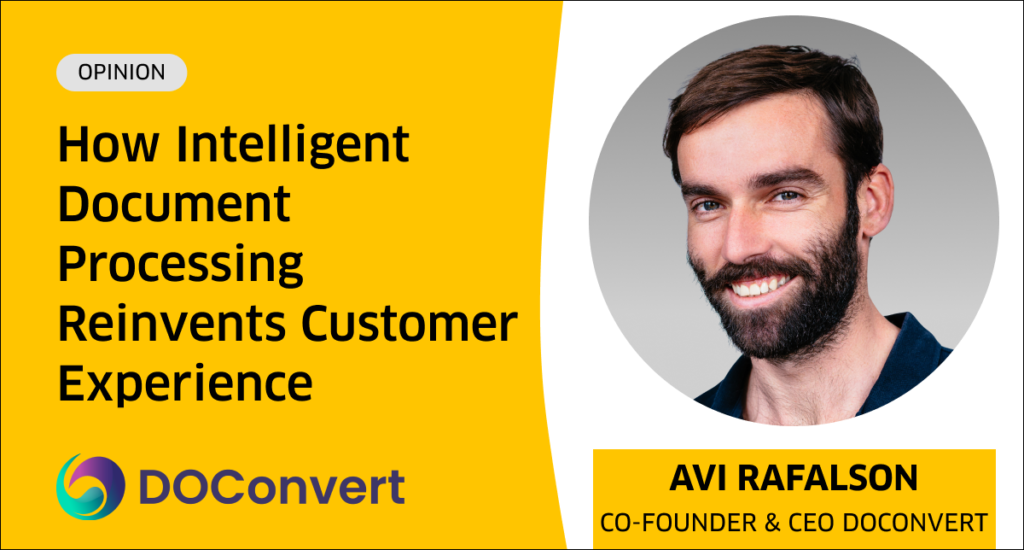Curious about what keeps experts, CEOs and other decision-makers in the Intelligent Document Processing (IDP) space on their toes? Get food for thought on IDP-related topics from the industry’s leading minds.
In this opinion piece, Avi Rafalson, Co-Founder and CEO of Intelligent Document Processing (IDP) vendor DOConvert, explains why IDP solutions are no longer just about extracting information, why the lines between document processing and business operations are blurring and what the key driver for this change is.
For years, Intelligent Document Processing (IDP) has been synonymous with extracting data from unstructured documents. The market, shaped by urgent business needs, prioritized automation that turned paper-based or digital documents into structured information. While this was revolutionary at the time, the expectations from IDP are evolving. Today, IDP solutions are no longer just about extracting information—they’re about deeply understand the extracted data, validate, compare, integrate and act on it before pushing it to ERP or other back office systems.
Thanks to new technologies and a shift in mindset toward solving old problems with innovative approaches, IDP has begun to transcend its original purpose. Businesses now demand solutions that not only digitize information but also integrate deeply into their workflows, delivering insights and automating decision-making at unprecedented levels. The foundation to enable these new capabilities is the bi-directional integration between next-generation IDP solutions and system of record systems.
The Era of Integration: Connecting Systems in Real-Time
At its core, bi-directional integration is about creating a seamless exchange of information between IDP solutions and other systems like Enterprise Resource Planning (ERP), Customer Relationship Management (CRM), or specialized supply chain tools. Unlike traditional unidirectional data transfer, bi-directional integration facilitates real-time communication, validation, and automation.
The significance of this approach lies in its ability to solve long-standing challenges in document management and data processing. For instance:
- Enhanced Workflow Accuracy: By linking document processing directly with ERP systems, data can be validated in real time. This eliminates errors such as mismatched SKUs, incorrect addresses, or missing price lists, which are common in supply chain or finance workflows.
- Proactive Anomaly Detection: The connection allows systems to identify and alert users to discrepancies (e.g., incorrect deliveries, missing information) before they escalate into larger problems.
- Dynamic Data Conversion: Bi-directional integration enables the transformation of data mid-process, ensuring compatibility with existing system formats, such as converting supplier codes to match customer databases.
- Leveraging Existing Data for Validation and Action: By utilizing data already housed in ERP or CRM systems, IDP solutions can validate or act on information at the document processing stage. This ensures that any inconsistencies are addressed before the data transitions from the IDP layer to the ERP or CRM systems.
This new functionality moves IDP beyond its initial focus on extracting data. Rather than simply positioning the technology as a strategic enabler, this approach establishes IDP as a new operational layer capable of automating tasks and use cases previously handled by humans or processed only after data transitioned into ERP/CRM systems. This innovation unlocks a host of new capabilities.
Why NOW, what drives the need for this innovation?
The shift toward bi-directional integration is driven by several key factors:
- The Rise of Complex Workflows: Modern business processes involve multiple stakeholders, systems, and data types. Traditional data extraction methods no longer suffice; integration is essential to keep workflows cohesive and accurate.
- Demand for Faster Decision-Making: As businesses face increasing pressure to reduce turnaround times, the ability to access and act on real-time data becomes critical. Bi-directional integration eliminates delays caused by manual data handling.
- Advances in AI and Machine Learning: Recent developments in AI have enabled IDP solutions to move beyond extraction, incorporating features like predictive analytics, contextual understanding, and decision support. These capabilities thrive when integrated deeply into existing systems.
- Business Continuity and Compliance: Organizations are under constant scrutiny to maintain compliance and ensure data integrity. Bi-directional integration provides the traceability and accuracy required for audits and regulatory requirements.
The Challenges and Opportunities of Bi-Directional Integration
Implementing bi-directional integration is not without its challenges. It requires:
- Robust APIs and Interoperability: Systems must be able to communicate effectively, which can be complex in organizations with legacy technology.
- Scalability: As document volumes grow, integration solutions must handle increasing data loads without compromising performance.
- User Adoption: Employees and stakeholders must adapt to new processes, which may require training and change management.
However, the opportunities far outweigh the challenges. Businesses that invest in bi-directional integration position themselves for:
- Improved Efficiency: Automation at every stage of the workflow reduces manual intervention and streamlines operations.
- Strategic Insights: Real-time data exchange enables systems to provide actionable intelligence, improving decision-making across departments.
- Competitive Advantage: Companies that adopt cutting-edge IDP technologies gain a significant edge over competitors still reliant on outdated processes.
A Vision for the Future of IDP
As IDP continues to evolve, the boundary between document processing and business operations will blur. Bi-directional integration is a key driver of this transformation, enabling IDP solutions to not only extract information but also interact with systems and workflows in meaningful ways.
In the near future, we can expect:
- Smarter Systems: IDP solutions will become integral to business ecosystems, leveraging AI to provide recommendations, automate decisions, and even predict future trends.
- Cross-Platform Collaboration: Integration across multiple platforms will become the norm, ensuring seamless data flow between IDP, ERP, CRM, and other enterprise tools.
- Greater Accessibility: As technologies mature, bi-directional integration will become more accessible to mid-market and smaller organizations, democratizing its benefits.
This is an exciting time for the IDP industry. The move toward bi-directional integration represents a fundamental shift, turning static data extraction into dynamic process automation. IDP solutions are no longer just applications—they are evolving into data and analytics platforms that play a broader role in digitizing and optimizing the supply chain. As technology continues to advance, the possibilities for innovation are limitless.

About the Author
Avi Rafalson is the CEO of DOConvert, a company at the forefront of Intelligent Document Processing solutions. With a passion for driving digital transformation, Avi is dedicated to helping manufacturers and distributors streamline their document processing workflows, optimize supply chain operations, and enhance overall efficiency.
You may also like:
How Intelligent Document Processing Reinvents Customer Experience

📨Get IDP industry news, distilled into 5 minutes or less, once a week. Delivered straight to your inbox ↓







